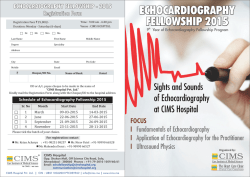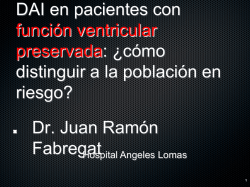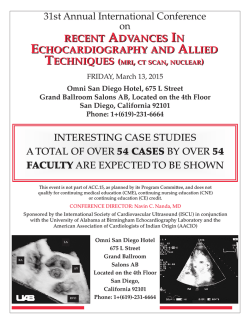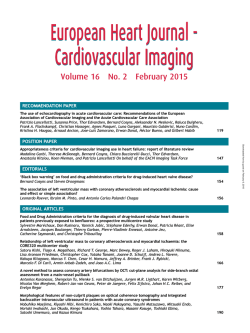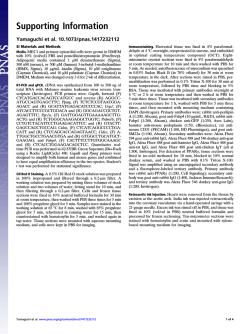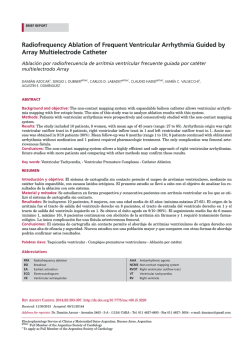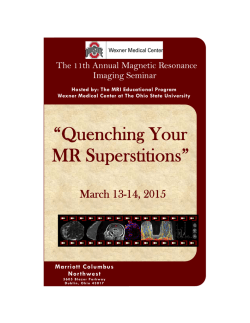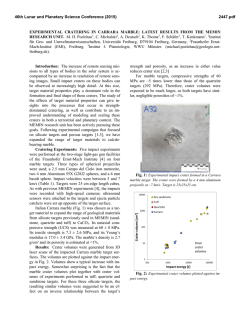
Validation of Real-Time Three-Dimensional Echocardiography for
Journal of the American College of Cardiology © 2000 by the American College of Cardiology Published by Elsevier Science Inc. Vol. 36, No. 3, 2000 ISSN 0735-1097/00/$20.00 PII S0735-1097(00)00793-2 Validation of Real-Time Three-Dimensional Echocardiography for Quantifying Left Ventricular Volumes in the Presence of a Left Ventricular Aneurysm: In Vitro and In Vivo Studies Jian Xin Qin, MD, Michael Jones, MD, Takahiro Shiota, MD, PHD, FACC, Neil L. Greenberg, PHD, Hiroyuki Tsujino, MS, Michael S. Firstenberg, MD, Pankaj C. Gupta, BA, Arthur D. Zetts, Yong Xu, MD, Jing Ping Sun, MD, Lisa A. Cardon, RDCS, Jill A. Odabashian, Scott D. Flamm, MD, Richard D. White, MD, Julio A. Panza, MD, FACC, James D. Thomas, MD, FACC Cleveland, Ohio and Bethesda, Maryland To validate the accuracy of real-time three-dimensional echocardiography (RT3DE) for quantifying aneurysmal left ventricular (LV) volumes. BACKGROUND Conventional two-dimensional echocardiography (2DE) has limitations when applied for quantification of LV volumes in patients with LV aneurysms. METHODS Seven aneurysmal balloons, 15 sheep (5 with chronic LV aneurysms and 10 without LV aneurysms) during 60 different hemodynamic conditions and 29 patients (13 with chronic LV aneurysms and 16 with normal LV) underwent RT3DE and 2DE. Electromagnetic flow meters and magnetic resonance imaging (MRI) served as reference standards in the animals and in the patients, respectively. Rotated apical six-plane method with multiplanar Simpson’s rule and apical biplane Simpson’s rule were used to determine LV volumes by RT3DE and 2DE, respectively. RESULTS Both RT3DE and 2DE correlated well with actual volumes for aneurysmal balloons. However, a significantly smaller mean difference (MD) was found between RT3DE and actual volumes (Ϫ7 ml for RT3DE vs. 22 ml for 2DE, p ϭ 0.0002). Excellent correlation and agreement between RT3DE and electromagnetic flow meters for LV stroke volumes for animals with aneurysms were observed, while 2DE showed lesser correlation and agreement (r ϭ 0.97, MD ϭ Ϫ1.0 ml vs. r ϭ 0.76, MD ϭ 4.4 ml). In patients with LV aneurysms, better correlation and agreement between RT3DE and MRI for LV volumes were obtained (r ϭ 0.99, MD ϭ Ϫ28 ml) than between 2DE and MRI (r ϭ 0.91, MD ϭ Ϫ49 ml). CONCLUSIONS For geometrically asymmetric LVs associated with ventricular aneurysms, RT3DE can accurately quantify LV volumes. (J Am Coll Cardiol 2000;36:900 –7) © 2000 by the American College of Cardiology OBJECTIVES Reliable quantification of left ventricular (LV) volumes and ejection fractions (EF) is important for serial assessment of LV remodeling after myocardial infarction (1,2), for consideration of surgical aneurysmectomy (3–5) and for predicting long-term outcome. Currently, two-dimensional echocardiography (2DE) using the biplane Simpson’s method of volume determination is the most common noninvasive tool used for the evaluation of LV volumes, but it is limited by assumptions about LV cavity geometry (5,6). A variety of three-dimensional echocardiographic systems have been developed with the goal of addressing issues about the geometric assumptions required by 2DE. By spatially and temporally registering sequential images, three-dimensional echocardiography has been reported to From the Cardiovascular Imaging Center, Department of Cardiology, the Cleveland Clinic Foundation, Cleveland, Ohio; Laboratory of Animal Surgery and Medicine, and Cardiology Branch, National Heart, Lung and Blood Institute, National Institutes of Health, Bethesda, Maryland. This study was supported, in part, by grant NCC9-60, National Aeronautics and Space Administration, Houston, Texas, and grant #9951522v from the American Heart Association Ohio Local Chapter, Columbus, Ohio, and grant #ROI-HL 56688-01A1 from the National Institutes of Health, Bethesda, Maryland. Manuscript received September 30, 1999; revised manuscript received March 7, 2000, accepted April 14, 2000. Downloaded From: http://content.onlinejacc.org/ on 02/06/2015 be valuable for evaluating asymmetric LV volumes and LV function, particularly in patients with LV aneurysms (7–11). However, these previously described methods require complex computer and echocardiographic analysis systems, carefully timed electrocardiogram/respiratory gating and prolonged imaging times (7–11). Because of these technical complexities, widespread clinical application has been limited. Recently, a real-time three-dimensional echocardiography (RT3DE) volume scanning technique has been developed to overcome these limitations in routine clinical settings (12–14). However, the application of this new technology for accurate quantification of LV volumes in the presence of LV aneurysms has not been validated. This study was designed to show that RT3DE is more accurate than 2DE for the quantification of volumes in aneurysmal LVs. To accomplish this goal, we: 1) validated the accuracy of RT3DE for quantifying modeled aneurysmal LV volumes in vitro; 2) determined the accuracy of RT3DE for measuring LV stroke volume (SV) compared with electromagnetic flow meter (EM) methods in a chronic LV aneurysm animal model; and 3) evaluated the feasibility and accuracy of RT3DE for measuring LV volumes compared with a reference standard of magnetic resonance Qin et al. Validation of Real-time 3DE Volumes JACC Vol. 36, No. 3, 2000 September 2000:900–7 Abbreviations and Acronyms 2DE ϭ two-dimensional echocardiography EDV ϭ end-diastolic volume EF ϭ ejection fraction EM ϭ electromagnetic flow meter ESV ϭ end-systolic volume LV ϭ left ventricle MD ϭ mean difference MRI ϭ magnetic resonance imaging RT3DE ϭ real-time three-dimensional echocardiography SV ϭ stroke volume imaging (MRI) in patients with and without ischemic aneurysmal heart disease. METHODS In vitro study. The accuracy of RT3DE for measuring volumes was tested in ventricular phantoms that were constructed of two balloons. A 2 to 4 cm incision was made in the apex of one balloon, and a second balloon was inserted into it through the incision. Water was instilled into the inside balloon to make the aneurysmal phantom (Fig. 1). Seven aneurysmal LV phantoms were created having volumes of 150 to 395 ml as determined by the amount of water used to fill each balloon. Real-time three-dimensional echocardiographic images of the balloons were acquired using a RT3DE system (Volumetrics Medical Imaging Inc., Durham, North Carolina) with a 2.5 MHz phased array hand-held transducer (14 mm in diameter). In addition, standard biplane 2DE images were obtained through the aneurysmal sections using a conventional ultrasound machine (PowerVision, Toshiba Corp., Tokyo, Japan). Animal Study Animal preparations. Fifteen sheep (weight, 40 Ϯ 15 kg) were studied including five sheep with chronic LV aneurysms created by left anterior diagonal coronary artery occlusion, six sheep with chronic aortic regurgitation with normal LV geometry and without coronary occlusion and four normal sheep. The animals with aortic regurgitation Figure 1. After the apex of the outside balloon was excised (dashed line), a second balloon was inserted into it. When filled with water, this produced a phantom apical aneurysm. Downloaded From: http://content.onlinejacc.org/ on 02/06/2015 901 were included so that the range of ventricular volumes, that is, those of normal sheep and sheep with aortic regurgitation, would approximate the ventricular volumes of the sheep with ventricular aneurysms. All of the sheep were anesthetized with pentobarbital (30 to 50 mg/kg intravenously) and 1 to 2% isoflurane, intubated and mechanically ventilated. A midline sternotomy was performed, the pericardium incised, and the heart was suspended in a pericardial cradle. An EM flow probe (model EP455, Carolina Medical Electronics, Inc, King, North Carolina) was placed around the skeletonized ascending aorta distal to the coronary ostia for measuring LV SV as a reference standard. All operative and animal management procedures were approved by the Animal Care and Use Committee of the National Heart, Lung and Blood Institute (14). Experimental protocol. Four hemodynamic conditions were obtained for each sheep and included baseline conditions, after 500 ml of blood infusion and during intravenous nitroprusside (50 g/ml) and angiotensin II (2 g/ml) infusion. Real-time three-dimensional images were acquired from the epicardial LV apex under each condition. All RT3DE images were stored on optical discs for off-line analysis. After each RT3DE data set acquisition, 2DE images were obtained from apical four-chamber and twochamber views and were recorded on one-half inch VHS videotape. Care was taken to include the largest LV cavity and aneurysm in the RT3DE pyramidal volumetric data set and 2DE image set for the entire cardiac cycle. Left ventricular SV obtained by integrating the instantaneous aortic forward flow rate measured during systole from the EM probe was compared to simultaneously recorded RT3DE and 2DE echocardiographic assessment of SVs. Patient Study Population. All patients (14 with coronary artery disease and known LV aneurysms and 20 patients without coronary artery disease) who underwent MRI, RT3DE and 2DE at the Cleveland Clinic Foundation during September 1997 and March 1999 were included in this study. Average age was 56 Ϯ 7 years old, and 23 of the 34 patients were men. Five patients (one patient with LV aneurysm and four patients without LV aneurysm) whose RT3DE image qualities were too poor for quantification were subsequently excluded. Study protocol. After institutional review board committee approval, written informed consent was obtained from each patient. In each patient, cardiac MRI was performed to determine LV volume and EF and was then followed by RT3DE and 2DE studies, each performed within 1 h of the other. RT3DE. Using the same RT3DE machine as in the phantom and animal study, image data set acquisition was performed from a transthoracic apical view with the patient in a left decubital supine position. The entire LV volumetric data set was acquired simultaneously including apical fourchamber views, apical two-chamber views and a series of 902 Qin et al. Validation of Real-time 3DE Volumes JACC Vol. 36, No. 3, 2000 September 2000:900–7 Figure 2. Left ventricular volume measurement by the apical six-plane method. Using as an axis of rotation the line from the apex to the center of the mitral valve annulus, the 3D Echotech system displayed the RT3DE images as six consecutive longitudinal planes rotated 30° from each adjacent plane. The LV cavity in each plane was traced manually, and the LV volume calculated by the multiplanar Simpson’s method. LV ϭ left ventricle; RT3DE ϭ real-time three-dimensional echocardiography. short axis images and was stored digitally after the highest quality image was obtained. Care was taken to include the entire LV cavity in the real-time pyramidal volumetric data set during the entire cardiac cycle. 2DE. Conventional transthoracic 2DE images were obtained in the apical four-chamber view and apical twochamber view with the same machine as in the phantom and animal studies. All of the 2DE studies were performed immediately after RT3DE examination. MRI. Magnetic resonance imaging was employed as a reference standard for determining absolute LV volumes in patients. All images were obtained with a commercially available 1.5 Tesla whole-body scanner (Siemens Vision, Erlangen, Germany) with a phased-array coil. Electrocardiogram-gated localizing spin-echo sequences were used to identify the intrinsic long axis of the heart. For all patients, short-axis dynamic gradient-echo (“Cine”) MRI images were started in the mitral valve plane with a slice thickness of 8 to 10 mm. These images were manually segmented using commercially available image analysis software (Argus, Siemens Medical Systems, Iselin, New Jersey) using Simpson’s algorithm to determine total LV volumes, that is, end-diastolic volume (EDV) and end-systolic volume (ESV). Ejection fraction was also calculated. All measurements were performed by an investigator experienced in cardiac MRI analysis and without knowledge of the RT3DE measurements. Quantitative RT3DE and 2DE measurements. For all RT3DE and 2DE images acquired from the animals and patients, LV EDV, ESV, SV (EDV-ESV) and EF (SV/ EDV) were determined. The RT3DE data sets were transferred to a computer system (3D EchoTech, Echo Tech America, Lafayette, Colorado) with a dedicated software program that was used to display the RT3DE images and to measure LV volumes. The computer automatically dis- Downloaded From: http://content.onlinejacc.org/ on 02/06/2015 played the dynamic RT3DE images as six apical images with a 30° angle between each image. The LV volumes were calculated using a series of symmetrically rotated apical six planes as previously described (15). The cavity of the LV in each image plane was manually traced, and the LV volume was calculated using the multiplanar Simpson’s method (Fig. 2). For 2DE, LV volumes were calculated using the biplane Simpson’s method from the apical four-chamber and two-chamber views. For all measurements, LV trabeculations and papillary muscles were carefully excluded from the LV cavity contour. Interobserver variability. In order to assess the effect of observational variability on the RT3DE measurement of LV volumes, the RT3DE images of a total of eight hemodynamic conditions in two sheep were analyzed off line at different times with the same computer by two independent observers, each without knowledge of the results obtained by the other or by EM. Figure 3. Linear regression between RT3DE, 2DE and actual volumes in the phantom study. RT3DE ϭ real-time three-dimensional echocardiography; 2DE ϭ two-dimensional echocardiography. Qin et al. Validation of Real-time 3DE Volumes JACC Vol. 36, No. 3, 2000 September 2000:900–7 Table 1. Left Ventricular Volumes Determined by RT3DE and 2DE in the Sheep Animal Model RT3DE Nonaneurysm Aneurysm 2DE Nonaneurysm Aneurysm n EDV (ml) ESV (ml) SV (ml) EF (%) 10 5 65 Ϯ 24 60 Ϯ 29 30 Ϯ 11 35 Ϯ 19 35 Ϯ 16 25 Ϯ 12 53 Ϯ 12 43 Ϯ 10 10 5 66 Ϯ 27 67 Ϯ 25* 31 Ϯ 14 37 Ϯ 15 36 Ϯ 16 31 Ϯ 13* 53 Ϯ 10 46 Ϯ 9 *Comparison with RT3DE, p Ͻ 0.05. 2DE ϭ two-dimensional echocardiography; EDV ϭ end-diastolic volume; EF ϭ ejection fraction; ESV ϭ end-systolic volume; RT3DE ϭ real-time threedimensional echocardiography; SV ϭ stroke volume. Statistical analysis. Values are expressed as mean Ϯ SD for continuous variables. The volume correlations between RT3DE, 2DE and actual volume in the phantom study, between RT3DE, 2DE and EM in the animal study and between RT3DE, 2DE and MRI in the patient study were performed using simple linear regression analysis. Correlation coefficients were compared after Fisher z-transformation. Agreement between methods was evaluated using the Bland and Altman method (16). Paired Student t tests were used to compare the difference between methods, and a value of p Ͻ 0.05 was considered statistically significant. RESULTS Phantom study. Cavity volumes, which included both balloon body volume and aneurysm volume, as determined by RT3DE and 2DE, correlated well with actual values: r-values were 0.996 and 0.990, respectively (Fig. 3). How- 903 ever, the average difference between the RT3DE and the actual values was significantly smaller than that between the 2DE and the actual values (Ϫ7 Ϯ 7 ml vs. 22 Ϯ 11 ml, p ϭ 0.0002). The 2DE method significantly overestimated actual cavity volumes (304 Ϯ 79 ml for 2DE vs. 282 Ϯ 76 ml for actual volume, p ϭ 0.001); the average percentage of overestimation was 8 Ϯ 5%. The RT3DE method slightly underestimated actual volumes (276 Ϯ 77 ml, p ϭ 0.04); the average percentage of underestimation was 3 Ϯ 3%. Experiment animal studies. Left ventricular aneurysm formation was confirmed by both RT3DE and 2DE three months after diagonal coronary artery occlusion in five of the LV aneurysm sheep. Left ventricular EDV, ESV, SV and EF measured by RT3DE and 2DE in normal sheep and those with aortic regurgitation and LV aneurysms are presented in Table 1. In the group without LV aneurysms, LV SV by EM methods ranged from 10 to 66 ml (34 Ϯ 16 ml). The correlation and agreement between RT3DE and the EM method was excellent (r ϭ 0.98, y ϭ 1.02x Ϫ 0.27, p Ͻ 0.0001). For 2DE, the correlation and agreement between 2DE and EM was moderately good (r ϭ 0.86, y ϭ 0.92x ϩ 3.80, p Ͻ 0.001, Fig. 4). In the LV aneurysm group, LV SV calculated by EM ranged from 14 to 58 ml (average 26 Ϯ 11 ml). For RT3DE, the correlation and agreement between RT3DE, and EMs were also excellent (r ϭ 0.97, y ϭ 1.07x Ϫ 2.97, p Ͻ 0.0001). For 2DE, only moderate correlation and agreement were obtained between 2DE and the EM method for LV SV (r ϭ 0.76, y ϭ 0.88x ϩ 7.61, p Ͻ 0.001, Fig. 5). While RT3DE showed a good agreement with EM for Figure 4. Linear regression and analysis of agreement between RT3DE, 2DE and EM for LV SV in the animals without LV aneurysms. Open circles ϭ data points from normal sheep; closed circles ϭ data points from sheep with aortic regurgitation. 2DE ϭ two-dimensional echocardiography; EM ϭ electromagnetic flow meter; LV ϭ left ventricle; RT3DE ϭ real-time three-dimensional echocardiography; SV ϭ stroke volume. Downloaded From: http://content.onlinejacc.org/ on 02/06/2015 904 Qin et al. Validation of Real-time 3DE Volumes JACC Vol. 36, No. 3, 2000 September 2000:900–7 Figure 5. Linear regression and analysis of agreement between RT3DE, 2DE and EM for LV SV in the animals with LV aneurysms. 2DE ϭ twodimensional echocardiography; EM ϭ electromagnetic flow meter; LV ϭ left ventricle; RT3DE ϭ real-time three-dimensional echocardiography; SV ϭ stroke volume. determination of LV SV (MD ϭ 0.4 Ϯ 2.9 ml and Ϫ1.0 Ϯ 3.4 ml, respectively, in both groups, p Ͼ 0.05), 2DE significantly overestimated LV SV obtained by EM (MD ϭ 2.1 Ϯ 9.8 ml for sheep without LV aneurysms and 4.4 Ϯ 8.4 ml for sheep with LV aneurysms, both p Ͻ 0.001). However, in normal sheep the agreement for LV SV between 2DE and EM methods was not significantly different from the agreement between RT3DE and EM (MD ϭ 0.4 Ϯ 2.9 ml for RT3DE vs. EM; 0.4 Ϯ 3.6 ml for 2DE vs. EM, open circles in Fig. 4). Although there was no significant difference for LV volume measurements between RT3DE and 2DE in the animals without LV aneurysms, 2DE significantly overestimated LV EDV by RT3DE (p Ͻ 0.05) and also tended to overestimate LV ESV in the animals with LV aneurysms, Table 1. Clinical studies. Results of LV EDV, ESV and EF measurements by RT3DE, 2DE and MRI are presented in Table 2. Compared with MRI, there were no significant differences for LV EF calculated by RT3DE and by 2DE both in the control and the LV aneurysm groups (p Ͼ 0.05). However, RT3DE and 2DE significantly underestimated LV EDV and LV ESV as determined by MRI in both groups. For comparison with MRI, linear regression analysis was used to determine the correlation with RT3DE and 2DE for the LV EDV and ESV measurements. For RT3DE, there was excellent correlation in both the control group and the LV aneurysm group (r ϭ 0.96, y ϭ 0.79x ϩ 7.54 ml, n ϭ 32, p Ͻ 0.0001, for the control group; r ϭ 0.99, y ϭ 0.78x ϩ 17.4 ml, n ϭ 26, p Ͻ 0.0001, for LV aneurysm group). Two-dimensional echocardiography correlated well with MRI in the control group (r ϭ 0.91, y ϭ 0.64x ϩ Downloaded From: http://content.onlinejacc.org/ on 02/06/2015 11.55 ml, n ϭ 32, p Ͻ 0.0001) and in the LV aneurysm group (r ϭ 0.91, y ϭ 0.75x ϩ 2.27, n ϭ 26, p Ͻ 0.0001). Although both RT3DE and 2DE underestimated the LV volumes measured by MRI, the MD between RT3DE and MRI was significantly smaller than that obtained between 2DE and MRI (Ϫ13 Ϯ 18 ml vs. Ϫ24 Ϯ 26 ml, p ϭ 0.0002, respectively, in the control group; Ϫ28 Ϯ 25 ml vs. Ϫ49 Ϯ 41 ml, p ϭ 0.002, respectively, in the LV aneurysm group). The average percentage underestimation of LV volume measured by MRI using RT3DE was significantly less than that using 2DE (11 Ϯ 16% vs. 20 Ϯ 19%, p ϭ 0.0001 in the control group; and 11 Ϯ 11% vs. 22 Ϯ 16%, p ϭ 0.04 in the LV aneurysm group). Overall, the LV volume measurement correlations between RT3DE and MRI were much better than the correlations between 2DE and MRI. Left ventricular SV measured by RT3DE, including Table 2. The LV EDV, ESV and EF Determined by RT3DE, 2DE and MRI in Patients MRI Aneurysms Control RT3DE Aneurysms Control 2DE Aneurysms Control n EDV (ml) ESV (ml) SV (ml) EF (%) 13 16 250 Ϯ 89* 142 Ϯ 47* 159 Ϯ 83* 59 Ϯ 24* 91 Ϯ 45* 81 Ϯ 26* 39 Ϯ 18 59 Ϯ 8 13 16 214 Ϯ 68 120 Ϯ 37 138 Ϯ 65 50 Ϯ 17 76 Ϯ 37 70 Ϯ 23 38 Ϯ 18 59 Ϯ 6 13 16 193 Ϯ 78 106 Ϯ 29 117 Ϯ 62 43 Ϯ 12 77 Ϯ 45 64 Ϯ 22 40 Ϯ 17 59 Ϯ 7 *Compared with the volumes measured by RT3DE or 2DE, p Ͻ 0.01. 2DE ϭ two-dimensional echocardiography; EDV ϭ end-diastolic volume; EF ϭ ejection fraction; ESV ϭ end-systolic volume; LV ϭ left ventricle; MRI ϭ magnetic resonance imaging; RT3DE ϭ real-time three-dimensional echocardiography; SV ϭ stroke volume. JACC Vol. 36, No. 3, 2000 September 2000:900–7 Qin et al. Validation of Real-time 3DE Volumes 905 Figure 6. The correlations and agreements between RT3DE, 2DE and MRI for LV SV in patients with (open circles) and without (closed circles) LV aneurysms. 2DE ϭ two-dimensional echocardiography; LV ϭ left ventricle; MRI ϭ magnetic resonance imaging; RT3DE ϭ real-time three-dimensional echocardiography; SV ϭ stroke volume. control and LV aneurysm patients, correlated and agreed with those measured by MRI (r ϭ 0.92, y ϭ 0.77x ϩ 6.73, MD ϭ Ϫ13 Ϯ 14 ml, p Ͻ 0.0001), but the correlation and agreement between 2DE and MRI for LV SV were decreased (r ϭ 0.82, y ϭ 0.78x ϩ 1.60, MD ϭ Ϫ17 Ϯ 21 ml, p Ͻ 0.001, Fig. 6). Interobserver variability. There was a good agreement between the two independent observers’ measurements of RT3DE volumes (58 Ϯ 27 ml vs. 57 Ϯ 27 ml, r ϭ 0.97, p Ͻ 0.0001, MD ϭ 1.3 Ϯ 1.6 ml). DISCUSSION In asymmetric LVs, especially those with aneurysms secondary to previous myocardial infarctions, accurate quantification of LV volumes and LV function is important for medical and surgical management. Although MRI, radionuclide angiography and cine ventriculography are used for the noninvasive or invasive determination of LV volumes and EF, these methods are expensive, time consuming, radiation exposing and impractical if repeated evaluations of LV function are needed (17–20). Various echocardiographic algorithms employing conventional 2DE techniques have been developed to determine LV volumes and EF. Because 2DE is expeditious, noninvasive, mobile and relatively inexpensive compared with the other methods, it has become the preferred diagnostic modality to evaluate LV structure and function. Although 2DE can detect or exclude LV aneurysms with a high sensitivity (93%) and specificity (94%) (21–23), the heterogeneous geometry and function of asymmetric ventricles makes it difficult to appreciate their shape, volume and function (5,6). In our phantom study, Downloaded From: http://content.onlinejacc.org/ on 02/06/2015 2DE significantly overestimated the actual volumes within aneurysmal balloons (MD ϭ 22 Ϯ 11 ml) since the sector plane was directed through the aneurysmal part, and the largest cavity areas were used to calculate volumes. Twodimensional echocardiography also significantly overestimated LV volumes compared with RT3DE measurements in our animal studies. This overestimation may be attributed to placement of the probe directly on the apex and inclusion of the largest portion of the aneurysm in the twodimensional imaging plane. Buck et al. (20) demonstrated the accuracy of reconstructed three-dimensional echocardiography for determining LV volumes and function in 23 patients with chronic LV aneurysms. They obtained dynamic three-dimensional echocardiographic image data sets from a transthoracic apical view using a rotating probe with acquisition gated to control for electrocardiogram and respiration variation. In their study, LV volumes were calculated from the threedimensional echocardiographic data sets by summating the volumes of multiple short axis parallel disks. When compared with MRI, their results showed excellent correlation and agreement for LV EDV (r ϭ 0.97, SEE ϭ 14.7 ml), for ESV (r ϭ 0.97, SEE ϭ 12.4 ml) and for EF (r ϭ 0.74, SEE ϭ 5.6%) and a better correlation and agreement than that obtained with two-dimensional techniques. However, these three-dimensional echocardiographic reconstruction methods are technically complicated and time-consuming (prolonged image acquisition and reconstruction time); therefore, clinical use has been limited. Compared with the reconstruction techniques of previously described three-dimensional echocardiographic methods, RT3DE has retained many of the clinical advantages of 906 Qin et al. Validation of Real-time 3DE Volumes 2DE. On-line adjustment of conventional echocardiographic planes can be performed to ensure adequate quality three-dimensional data sets. Once the entire LV was included in the RT3DE data sets, the apical aneurysm present could be displayed by six rotated apical long axis planes. The quantification of LV volumes can be performed quickly when using the apical six-plane method instead of using traditional short axis views (a series of C-scans) (15,24). In addition, since the RT3DE hand-held probe is similar to that of the transthoracic 2DE probe, sonographers do not need extraordinary expertise for acquiring RT3DE data sets, a major advantage over the previously reported reconstruction methods of three-dimensional echocardiography (7– 11,25). Another advantage of RT3DE imaging is the elimination of the need for electrocardiogram or respiratory gating. These factors are particularly important for studying critically ill patients, for acquiring epicardial RT3DE images in the operation room and for imaging patients with arrhythmias (24). Study limitations. The limited pyramidal angle and low frame rate of current RT3DE may be major factors for the volume underestimation in patients. In patients with dilated hearts, the 60° ϫ 60° pyramidal angle often limits the ability to image the entire ventricle. We have shown in our initial study and in this study that RT3DE significantly underestimated LV volumes when compared with MRI in patients with severely dilated ventricles (24). Inadequate resolution of the LV endocardium because of the mitral valve apparatus and low lateral resolution of the RT3DE images may explain this underestimation. Also contributing to this is the MRI technique itself, by which endocardial tracing tends to include LV trabeculations, whereas they are excluded by 2DE and RT3DE. The maximal achievable frame rate is only 20 frames per second at an image depth of 14 cm. Low frame rates may be problematic for capturing precise end-diastolic and endsystolic frames, especially in the presence of tachycardia. This imprecision is another reason for RT3DE underestimation of LV volumes, especially LV EDV under clinical conditions. Conclusions. Real-time three-dimensional echocardiography showed excellent correlation and agreement with actual volumes in a phantom study, for LV SV versus EM in a chronic LV aneurysm animal model and for absolute LV volumes versus MRI in patients with known LV aneurysms. These correlations and agreements were better than those obtained by conventional 2DE. Our results demonstrate the feasibility and validate the accuracy of RT3DE for the clinical assessment of patients with asymmetric LVs. Acknowledgment We acknowledge the assistance of the veterinary professional and technical staff of the Laboratory of Animal Medicine and Surgery, National Heart, Lung and Blood Institute, National Institutes of Health. Downloaded From: http://content.onlinejacc.org/ on 02/06/2015 JACC Vol. 36, No. 3, 2000 September 2000:900–7 Reprint requests and correspondence: Dr. Takahiro Shiota, Department of Cardiology/Desk F 15, The Cleveland Clinic Foundation, 9500 Euclid Avenue, Cleveland, Ohio 44195. E-mail:[email protected]. REFERENCES 1. Ertl G, Gaudron P, Eilles C, Kochsiek K. Serial changes in left ventricular size after acute myocardial infarction. Am J Cardiol 1991;68:116D–20D. 2. Picard MH, Wilkins GT, Ray PA, Weyman AE. Natural history of left ventricular size and function after acute myocardial function. Assessment and prediction by echocardiographic endocardial surface mapping. Circulation 1990;82:484 –94. 3. Visser CA, Kan G, Meltzer RS, Moulijn AC, David GK, Dunning AJ. Assessment of left ventricular aneurysm resectability by twodimensional echocardiography. Am J Cardiol 1985;56:857– 60. 4. Cohen M, Packer M, Gorlin R. Indications for left ventricular aneurysmectomy. Circulation 1983;67:717–22. 5. Ryan T, Petrovic O, Armstrong WF, Dillon JC, Feigenbaum H. Quantitative two-dimensional echocardiographic assessment of patients undergoing left ventricular aneurysmectomy. Am Heart J 1986; 111:714 –20. 6. Mitchell GF, Lamas GA, Vaughan DE, Pfeffer MA. Left ventricular remodeling in the year after first anterior myocardial infarction: a quantitative analysis of contractile segment lengths and ventricular shape. J Am Coll Cardiol 1992;19:1136 – 44. 7. Gopal AS, King DL, Katz J, Boxt LM, King DL Jr, Shao MY. Three-dimensional echocardiographic volume computation by polyhedral surface reconstruction: in vitro validation and comparison to magnetic resonance imaging. J Am Soc Echocardiogr 1992;5:115–24. 8. Siu SC, Rivera JM, Guerrero JL, et al. Three-dimensional echocardiography. In vivo validation for left ventricular volume and function. Circulation 1993;88:1715–23. 9. Jiang L, Vazquez de Prada JA, Handschumacher MD, et al. Quantitative three-dimensional reconstruction of aneurysmal left ventricles. In vitro and in vivo validation. Circulation 1995;91:222–30. 10. Yao J, Cao QL, Masani N, et al. Three-dimensional echocardiographic estimation of infarct mass based on quantification of dysfunctional left ventricular mass. Circulation 1997;96:1660 – 6. 11. Pini P, Giannazzo G, Di Bari M, et al. Transthoracic threedimensional echocardiographic reconstruction of left and right ventricles: in vitro validation and comparison with magnetic resonance imaging. Am Heart J 1997;133:221–9. 12. von Ramm OT, Smith SW. Real-time volumetric ultrasound imaging system. J Digital Imaging 1990;3:261– 6. 13. Smith SW, Pavy HG, von Ramm OT. High-speed ultrasound volumetric imaging system—Part 1: transducer design and beam steering. IEEE Transactions on Ultrasonics and Frequency Control 1991;38:100 – 8. 14. Shiota T, Jones M, Chikada M, et al. Real-time three-dimensional echocardiography for determining right ventricular stroke volume in an animal model of chronic right ventricular volume overload. Circulation 1998;97:1897–1900. 15. Qin JX, Shiota T, Sun JP, et al. A new digital method for estimating left ventricular volume using real-time three-dimensional echocardiography: a comparison with magnetic resonance imaging (abstr). J Am Coll Cardiol 1999;33:441A. 16. Bland JM, Altman DG. Statistical methods for assessing agreement between two methods of clinical measurements. Lancet 1986;1:307– 10. 17. Dulce MC, Mostbeck GH, Friese KK, Caputo GR, Higgins CB. Quantification of the left ventricular volumes and function with cine MR imaging: comparison of geometric models with three-dimensional data. Radiology 1993;188:371– 6. 18. Hains AD, Al-Khawaja I, Hinge DA, Lahiri A, Raftery EB. Radionuclide left ventricular ejection fraction: a comparison of three methods. Br Heart J 1987;57:242– 6. 19. Shah PK, Pichler M, Berman DS, Singh BN, Swan HJ. Left ventricular ejection fraction determined by radionuclide ventriculography in early stages of first transmural myocardial infarction. Am J Cardiol 1980;45:542– 6. JACC Vol. 36, No. 3, 2000 September 2000:900–7 20. Buck, T, Hunold P, Wentz KU, Tkalec W, Nesser HJ, Erbel R. Tomographic three- dimensional echocardiographic determination of chamber size and systolic function in patients with left ventricular aneurysm: comparison to magnetic resonance imaging, cineventriculography and two-dimensional echocardiography. Circulation 1997; 96:4286 –97. 21. Weyman AE, Peskoe SM, Williams ES, Dillon JC, Feigenbaum H. Detection of left ventricular aneurysms by cross-sectional echocardiography. Circulation 1976;54:936 – 44. 22. Baur HR, Daniel JA, Nelson RR. Detection of left ventricular aneurysm on two-dimensional echocardiography. Am J Cardiol 1982; 50:191– 6. Downloaded From: http://content.onlinejacc.org/ on 02/06/2015 Qin et al. Validation of Real-time 3DE Volumes 907 23. Visser CA, Kan G, David GK, Lie KI, Durrer D. Echocardiographic-cineangiographic correlation in detecting left ventricular aneurysm: a prospective study of 422 patients. Am J Cardiol 1982;50:337– 41. 24. Shiota T, McCarthy PM, White RD, et al. Initial clinical experience of real-time three-dimensional echocardiography in patients with ischemic and idiopathic dilated cardiomyopathy. Am J Cardiol 1999; 84:1068 –73. 25. Nosir YF, Fioretti PM, Vletter WB, et al. Accurate measurement of left ventricular ejection fraction by three-dimensional echocardiography. A comparison with radionuclide angiography. Circulation 1996,94:460 – 6.
© Copyright 2026
